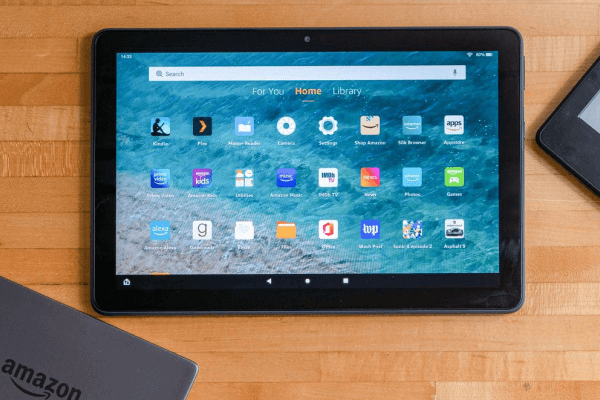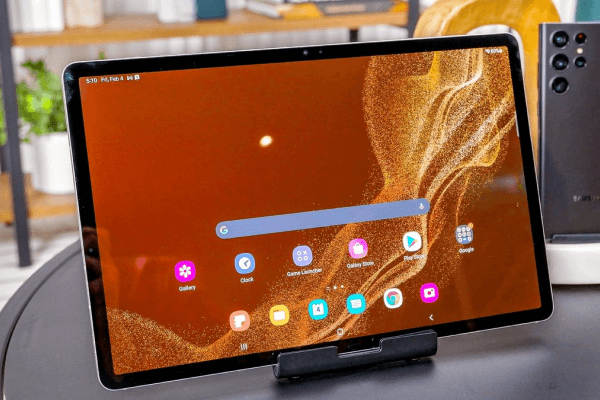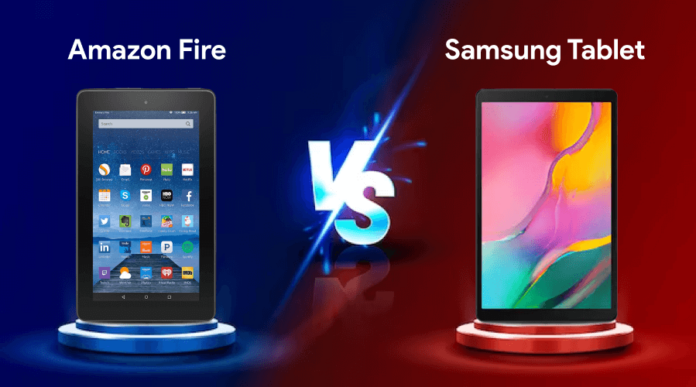In an era dominated by portable technology, the quest for the perfect tablet has become a pivotal decision. Amidst the myriad choices, the showdown between the Amazon Fire vs. Samsung Tablet beckons. Each boasting distinctive features, these devices cater to diverse needs, weaving a digital narrative of individuality.
This exploration transcends the conventional comparison, delving into performance, software nuances, and user experiences. Embark on a journey where affordability meets sophistication and where the selection of a tablet becomes not just a choice but a tailored extension of one’s digital aspirations. Let the clash of titans unfold in the Amazon Fire vs Samsung Tablet arena.
Here is a complete guide to Amazon Fire vs. Samsung Tablet
 Amazon Fire Tablet
Amazon Fire Tablet

I. Overview of Amazon Fire series
The Amazon Fire Tablet series represents a budget-friendly yet feature-rich lineup designed for various user needs. With a focus on affordability and functionality, these tablets offer a gateway into the Amazon ecosystem.
II. Key features and specifications
- Display: 7-inch IPS display
- Processor: Quad-core 1.3 GHz
- Storage: 16GB (expandable up to 512GB with microSD)
- Battery life: Up to 7 hours of reading, browsing the web, watching videos, and listening to music.
- Camera: 2 MP front and rear-facing cameras
- Connectivity: Wi-Fi
- Audio: Mono speaker, built-in microphone, 3.5mm stereo jack
- Weight: 10.1 oz (286 grams)
- Dimensions: 7.6″ x 4.5″ x 0.4″ (192 x 115 x 9.6 mm)
III. Pros and Cons

- Pro: Priced at an attractive $59.99, it is one of the most budget-friendly tablets on the market.
- Con: Some compromises in build quality and advanced features.

- Pro: Seamless integration with Amazon services, including Kindle, Prime Video, and Alexa.
- Con: Limited access to Google services may affect app choices.

- Pro: Streamlined interface for ease of use.
- Con: Restricted app selection compared to tablets running standard Android.

The Amazon Fire Tablet, with its compelling price point, provides an excellent entry into the tablet market, especially for users looking to leverage the Amazon ecosystem for their digital needs.
 Samsung Tablet
Samsung Tablet

I. Introduction to Samsung’s tablet lineup
Samsung’s tablet lineup epitomizes cutting-edge technology and elegant design, offering users a sophisticated and versatile digital experience. Renowned for their premium build quality and innovation, Samsung tablets cater to diverse users seeking a blend of style and performance.
II. Highlighting key features and specifications
- Display: 10.1-inch WUXGA display with a resolution of 1920 x 1200 pixels
- Processor: Octa-core processor for enhanced multitasking and smooth performance
- Storage: Available in 32GB and 64GB variants, expandable up to 512GB with a microSD card
- Battery life: Long-lasting battery for extended use
- Camera: 8 MP rear camera and 5 MP front-facing camera for high-quality photos and video calls
- Connectivity: Wi-Fi and optional LTE connectivity for on-the-go usage
- Audio: Stereo speakers tuned by AKG, Dolby Atmos support
- Weight: Varies by model, typically ranging from 1 to 1.5 pounds
- Dimensions: Varies by model
Also See: How to Take a Screenshot on Samsung
III. Pros and Cons

- Pro: Sleek and premium design with attention to detail.
- Con: The premium design comes with a higher price tag.

- Pro: Versatile features catering to productivity, entertainment, and creativity.
- Con: It may have a steeper learning curve for users new to Samsung’s ecosystem.

- Pro: Reflects the tablet’s premium features and build.
- Con: Higher initial investment compared to budget-friendly options.

The Samsung Tablet is a symbol of elegance and innovation, offering users a premium tablet experience with advanced features, making it an ideal choice for those who prioritize style and functionality in their digital devices.
Samsung Tablets vs. Amazon Fire: 7 Must-Know Facts
1. Diverse Ecosystems
Samsung tablets thrive within the expansive Android ecosystem, providing access to many apps via the Google Play Store. In contrast, Amazon Fire tablets are tightly integrated into Amazon’s ecosystem, delivering a seamless experience for users deeply embedded in the Amazon universe.
2. Build Quality and Design
Samsung tablets are renowned for their premium build quality and sleek designs, offering a sophisticated feel. On the flip side, Amazon Fire tablets, while budget-friendly, may compromise slightly on build materials to maintain their affordability.
3. Affordability vs. Premium Pricing
Amazon Fire tablets, with a starting price as low as $59.99, cater to budget-conscious consumers. In contrast, Samsung tablets often have a higher price tag, reflecting their premium features and advanced capabilities.
4. App Selection and Customization
As part of the broader Android ecosystem, Samsung tablets provide users with an extensive selection of apps. However, Amazon Fire tablets, running a customized version of Android, have a more limited app selection due to their focus on Amazon’s proprietary app store.
5. Performance and Hardware
Samsung tablets, equipped with powerful processors and high-quality displays, offer a robust performance suitable for various tasks. Amazon Fire tablets, while capable, may have more modest hardware configurations to meet their budget-friendly positioning.
6. Content Consumption vs. Productivity
Amazon Fire tablets shine in content consumption, especially for users heavily invested in Amazon Prime services. On the other hand, Samsung tablets are designed for versatility, catering to content consumption and productivity with features like Samsung DeX.
7. Integration with Other Devices
Samsung tablets seamlessly integrate with other Samsung devices, fostering a cohesive ecosystem. Meanwhile, Amazon Fire tablets excel in integration within the Amazon device family, enhancing the overall smart home experience.
Amazon Fire Vs. Android Tablet: Which is Better
The tug-of-war between Amazon Fire and Android tablets intensifies in the realm of tablets. Amazon Fire tablets, born from affordability, seamlessly integrate into the Amazon ecosystem. Meanwhile, Android tablets boast a broader app selection and customizable experience.
The budget-friendly allure of Amazon Fire competes with the versatility of Android tablets. Whether navigating Amazon’s walled garden or relishing the expansiveness of Android’s playground, the choice boils down to personal preferences. Unravel the layers, weigh the trade-offs, and unveil the tablet that aligns seamlessly with your digital desires.
Conclusion
In concluding our exploration of the Amazon Fire and Samsung Tablet face-off, it’s evident that both devices cater to distinct preferences. If you’re inclined towards an affordable entry into the tablet realm with seamless integration into Amazon’s ecosystem, the Amazon Fire tablet stands out.
On the flip side, Samsung Tablets provide a premium experience at a higher cost, offering top-notch features and a sophisticated design. The choice between Amazon Fire and Samsung Tablet ultimately depends on individual needs and priorities. So, whether you prioritize budget-friendliness or seek a high-end device, decide based on what aligns best with your digital requirements.

